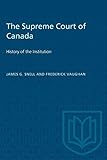The Supreme Court of Canada : History of the Institution / Frederick Vaughan, James G. Snell.
Material type: TextSeries: HeritagePublisher: Toronto : University of Toronto Press, [1985]Copyright date: ©1985Description: 1 online resource (344 p.)Content type:
TextSeries: HeritagePublisher: Toronto : University of Toronto Press, [1985]Copyright date: ©1985Description: 1 online resource (344 p.)Content type: - 9780802034182
- 9781487575298
- 347.71/035 347.10735 19
- KE8244 .S64 1985
- online - DeGruyter
| Item type | Current library | Call number | URL | Status | Notes | Barcode | |
|---|---|---|---|---|---|---|---|
 eBook
eBook
|
Biblioteca "Angelicum" Pont. Univ. S.Tommaso d'Aquino Nuvola online | online - DeGruyter (Browse shelf(Opens below)) | Online access | Not for loan (Accesso limitato) | Accesso per gli utenti autorizzati / Access for authorized users | (dgr)9781487575298 |
restricted access online access with authorization star
http://purl.org/coar/access_right/c_16ec
Unknown and uncelebrated by the public, overshadowed and frequently overruled by the Privy Council, the Supreme Court of Canada before 1949 occupied a rather humble place in Canadian jurisprudence as an intermediate court of appeal. Today its name more accurately reflects its function: it is the court of ultimate appeal and the arbiter of Canada's constitutional questions. Appointment to its bench is the highest achievement to which a member of the legal profession can aspire. This history traces the development of the Supreme Court of Canada from its establishment in the earliest days following Confederation, through its attainment of independence from the Judicial Committee of the Privy Council in 1949, to the adoption of the Constitution Act, 1982. The authors describe the politics of the judicial apopintments and document the internal struggles and tensions between the justices. Central to the story is the attitude of successive federal governments to the need for a strong and intellectually vibrant court. Not all prime ministers and ministers of justice took an interest in the Court, and some of their appointments were of less than outstanding quality. Only in recent times have appointments been of consistently high calibre. Until 1982 the Supreme Court of Canada played a minor role in the history of the Canadian political structure. The Charter of Rights and Freedoms has thrust new responsibilities on the Court, and as those responsibilities are increasingly exercised in the years ahead the Court will become a major participant in our national life. This book explores the foundations on which that participation will be built.
Mode of access: Internet via World Wide Web.
In English.
Description based on online resource; title from PDF title page (publisher's Web site, viewed 01. Nov 2023)


